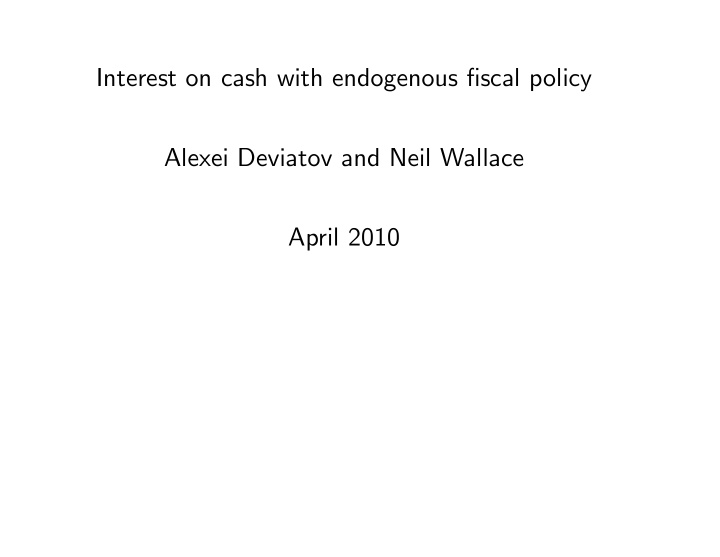



Interest on cash with endogenous …scal policy Alexei Deviatov and Neil Wallace April 2010
Monetary policy cannot be studied without describing …scal policy � allowable …scal instruments � how they are used � (see, for example, Correia, I., J. Nicolini and P. Teles, Optimal …scal and monetary policy: equivalence results. JPE 2008) This paper � policy implied by frictions that generate role for money � main friction is imperfect monitoring
Imperfect monitoring and the role of currency Observations � currency used to evade taxation � currency used in the underground economy Suggest a connection between � the role of currency and � feasible taxation
Preview Model based on Cavalcanti-Wallace 1999: � an above-ground economy (perfectly monitored) � an underground economy (anonymous) � heterogeneous one-time costs of becoming monitored For some examples, � compute optimum (max ex ante representative-agent welfare) � examine interest rate paid on currency at the optimum
The environment � discrete time � measure of in…nitely-lived people with discounted (at rate � ) utility preferences � period utility is u ( x ) � c ( y ) � production is perishable
Monitoring Initial and permanent split of people into two groups � m people: perfectly monitored � n people: anonymous, not monitored at all, can hide money � people publicly choose m or n status after receiving a private and independent draw from a distribution of – additively separable one-time utility cost of becoming m – the distribution is the realized cross-section distribution of costs
Meetings and money Two stages at each date � Stage 1: production and consumption in pairwise meetings at random with no double-coincidences ( 1 =K is prob of being producer and is prob of being consumer, K � 2 ) � Stage 2: transfers of money Outside money � individual money holdings in f 0 ; 1 g � money disintegrates at rate � 2 [0 ; 1]
0ptimal allocations Allocations (initial distributions, trades, transfers) that maximize ex ante welfare subject to symmetry , stationarity , truth-telling , and no defection Defections: � individual and cooperative defections in stage 1 meetings � individual defection at stage 2 Punishment: an m agent ! n agent
Extreme cases and the choice of � First-best: y � = arg max[ u ( y ) � c ( y )] Everyone is m : …rst-best is implementable if u ( y � ) c ( y � ) � 1 + K (1 � � ) =�: (1) Everyone is n : relevant constraint is u ( y ) c ( y ) � 1 + K (1 � � ) =� : (2) 1 � � � 2 [ � � ; � � ] , where � � = � � ( ) ( 1 ) at equality ) ( 2 ) at equality when y = y � and � = 1 = 2 � � = � � (
Rate of return on money for n people ( R ) For consumer types s 2 f ( n; 1) ; ( m; 1) g , let expected discounted goods obtained R ( s ) = output produced by ( n; 0) for consumer s R = average over s (Friedman rule: R = 1 ) R is a¤ected by � the distribution of money � trades between n people and m people � disintegration rate
Examples u ( y ) = 1 � e � 10 y ; c ( y ) = y; K = 3 Implies u 0 (0) = 10 , y � = ln(10) = 10 � : 23 and 1 � � = � 0 : 5077 1 + (9 = ln 10) � 1 3 1 � � = � 0 : 6735 : 1 + (9 = ln 10) � 1 6
Lower-bound benchmark: everyone (treated as) n � ( n; 1) y=y � � � R 0 W 0 � � 0.38 0.55 1 0.18 0.09 � � +� � 0.45 0.76 1 0.21 0.13 2 � � 0.51 1.00 1 0.26 0.17
Exogenous fraction who are monitored R=R 0 when fraction of m is � � n � 1 = 4 1 = 2 3 = 4 � � 0.84 0.81 unde…ned � � +� � 0.91 0.88 unde…ned 2 � � 0.95 0.95 1.04
Details for � = � � +� � and � = 1 = 4 2 Ev m =W 0 Ev n =W 0 � ( m 1) � ( n 0) � ( n 1) W=W 0 � 1.43 3.20 0.87 1/4 0.57 0.18 0.16 y=y � stage-1 meeting � (n0)(n1) � 0.573 1 (n0)(m1) � 0.573 1 (m1)(n0) 0.113 - (m1)(n1) �y 0.381 1 (m1)(m1) � 0.381 -
Endogenous choice of m status Aggregate features: � = � � +� � , F = F (1 = 4 ;� ) ( x ) 2 Ev m =W 0 Ev n =W 0 � ( m 1) � ( n 0) � W=W 0 R=R 0 � 0 1.43 3.20 0.83 .250 .574 0.909 .159 : 2 1.35 3.16 0.85 .249 .574 0.909 .156 : 4 1.28 3.12 0.86 .244 .575 0.911 .151 : 6 1.21 3.06 0.88 .235 .579 0.915 .143
Concluding remarks Most studies omit the restrictions for feasible policies implied by the fric- tions that give money a role The omission is important. Why, for example, estimate US welfare costs of in‡ation ignoring: � half of U.S. currency is held abroad � currency heavily used in illegal activity � explicit policy goal is to inhibit the use of currency This paper: even with benign underground economy, an optimum does not always use feasible taxation to raise the return on currency
Recommend
More recommend